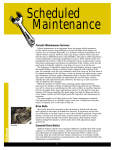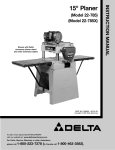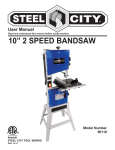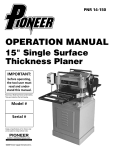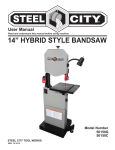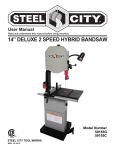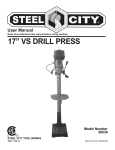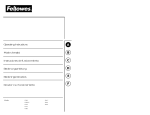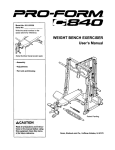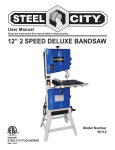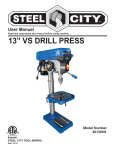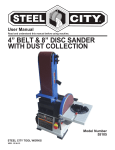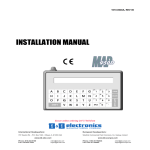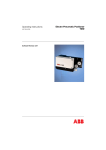Download 15” PLANER - Steel City Tool Works
Transcript
®® User Manual Read and understand this manual before using machine. 15” PLANER STEELCITYTOOLWORKS VER. 11.22.13 Model Number 40255 40255H ® l City Planer. ee St w ne ur yo ng si ha rc THANK YOU for pu inspected with you, d an , ed st te , ed gn si de This planer has been , used and mained bl m se as ly er op pr n he the customer, in mind. W years of trouble free ith w u yo e id ov pr ill w tained, your planer best machinery e th of e on by ed ck ba is service, which is why it ss. warranties in the busine ucts in the Steel City’s od pr y an m of e on st ju This planer is t proof of our commitmen is d an ry ne hi ac m ng ki family of woodwor ction. to total customer satisfa cellence each and every ex r fo e riv st to ue in nt At Steel City we co . For comments er om st cu r ou u, yo of n day and value the opinio ks, please visit our web or W ol To ity C l ee St or about your planer works.com . site at www.steelcitytool TABLE OF CONTENTS IMPORTANT SAFETY & GUIDELINES.....................1 GENERAL SAFETY RULES ......................................2 ADDITIONAL SPECIFIC SAFETY RULES ................3 ELECTRICAL SAFETY PRECAUTIONS ...................4 FUNCTIONAL DESCRIPTION ..................................4 CARTON CONTENTS ............................................5-6 PRODUCT SPECIFICATIONS ..................................7 PLANER STAND ASSEMBLY...................................8 HOW TO LIFT THE MACHINE ..................................9 ATTACHING THE PLANER TO THE STAND ...........9 ATTACHING HANDWHEEL ....................................10 ATTACHING TOP COVER AND DUST HOOD...............11 HOW TO ATTACH THE WINGS .....................................11 OPERATING CONTROLS AND ADJUSTMENTS...........12 HOW TO CONTROL THE FEED SPEED .......................13 HOW TO CHECK, ADJUST & REPLACE KNIVES .........14 HOW TO SET A KNIFE .............................................15-16 HOW TO ADJUST THE TABLE ROLLERS.....................17 ADJUST THE HEIGHT OF THE CHIPBREAKER .....18-19 MAINTENANCE ..............................................................20 TROUBLESHOOTING ....................................................21 IMPORTANT SAFETY INSTRUCTIONS WARNING: Read all warnings and operating instructions before using any tool or equipment. When using tools or equipment, basic safety precautions should always be followed to reduce the risk of personal injury. Improper operation, maintenance or modification of tools or equipment could result in serious injury and property damage. There are certain applications for which tools and equipment are designed. Steel City Tool Works strongly recommends that this product NOT be modified and/or used for any application other than for which it was designed. If you have any questions relative to its application DO NOT use the product until you have contacted Steel City Tool Works and we have advised you. Contact us online at www.steelcitytoolworks.com or call 877-724-8665. Information regarding the safe and proper operation of this tool is available from the following sources: ,QVWLWXWHPower Tool 1300 Sumner Avenue, Cleveland, OH 44115-2851 or online at www.powertoolinstitute.com 1DWLRQDO6DIHW\&RXQFLO1121 Spring Lake Drive, Itasca, IL 60143-3201 American National Standards Institute, 25 West 43rd Street, 4floor, NewYork, NY 10036 www.ansi.org - ANSI 01.1 Safety Requirements for Woodworking Machines 86'HSDUWPHQWRI/DERUUHJXODWLRQVZZZ.osha.gov SAVE THESE INSTRUCTIONS! SAFETY GUIDELINES - DEFINITIONS It is important for you to read and understand this manual. The information it contains relates to protecting YOUR SAFETY and PREVENTING PROBLEMS. The symbols below are used to help you recognize this information. DANGER: indicates an imminently hazardous situation which, if not avoided,will result in death or serious injury. WARNING: indicates a potentially hazardous situation which, if not avoided,could result in death or serious injury. CAUTION: indicates a potentially hazardous situation which, if not avoided, may result in minor or moderate injury. NOTICE: indicates a practice not related to personal injury which, if not avoided, may result in property damage. WARNING: Some dust created by power sanding, sawing, grinding, drilling, and other construction activities contains chemicals known to the State of California to cause cancer, birth defects or other reproductive harm. Some examples of these chemicals are: Lead from lead-based paints Crystalline silica from bricks and cement and other masonry products Arsenic and chromium from chemically-treated lumber (CCA). Your risk from these exposures varies, depending on how often you do this type of work. To reduce your exposure to these chemicals: work in a well-ventilated area, and work with approved safety equipment, such as those dust masks that are specially designed to filter out microscopic particles. 1 GENERAL SAFETY RULES WARNING: Failure to follow these rules may result in serious personal injury. 1. For your own safety, read the instruction manual before operating the machine. Learning the machine’s application, limitations, and specific hazards will greatly minimize the possibility of accidents and injury. 2. Wear eye and hearing protection and always use safety glasses. Everyday eyeglasses are not safety glasses. Use certified safety equipment. Eye protection equipment should comply with ANSI Z87.1 standards. Hearing equipment should comply with ANSI S3.19 standards. 3. Wear proper apparel. Do not wear loose clothing, gloves, neckties, rings, bracelets, or other jewelry which may get caught in moving parts. Nonslip protective footwear is recommended. Wear protective hair covering to contain long hair. 4. Do not use the machine in a dangerous environment. The use of power tools in damp or wet locations or in rain can cause shock or electrocution. Keep your work area well-lit to prevent tripping or placing arms, hands, and fingers in danger. 5. Do not operate electric tools near flammable liquids or in gaseous or explosive atmospheres. Motors and switches in these tools may spark and ignite fumes. 6. Maintain all tools and machines in peak condition. Keep tools sharp and clean for best and safest performance. Follow instructions for lubricating and changing accessories. Poorly maintained tools and machines can further damage the tool or machine and/or cause injury. 7. Check for damaged parts. Before using the machine, check for any damaged parts. Check for alignment of moving parts, binding of moving parts, breakage of parts, and any other conditions that may affect its operation. A guard or any other part that is damaged should be properly repaired or replaced with SCTW or factory authorized replacement parts. Damaged parts can cause further damage to the machine and/or injury. 8. Keep the work area clean. Cluttered areas and benches invite accidents. 9. Keep children and visitors away. Your shop is a potentially dangerous environment. Children and visitors can be injured. 10. Reduce the risk of unintentional starting. Make sure that the switch is in the “OFF” position before plugging in the power cord. In the event of a power failure, move the switch to the “OFF” position. An accidental start-up can cause injury. Do not touch the plug’s metal prongs when unplugging or plugging in the cord. 11. Use the guards. Check to see that all safety devices are in place, secured, and working correctly to prevent injury. 12. Remove adjusting keys and wrenches before starting the machine. Tools, scrap pieces, and other debris can be thrown at high speed, causing injury. 13. Use the right machine. Don’t force a machine or an attachment to do a job for which it was not designed. Damage to the machine and/or injury may result. 14. Use recommended accessories. The use of accessories and attachments not recommended by SCTW may cause damage to the machine or injury to the user. 2 15. Use the proper extension cord. Make sure your extension cord is in good condition. When using an extension cord, be sure to use one heavy enough to carry the current your product will draw. An undersized cord will cause a drop in line voltage, resulting in loss of power and overheating. See the Extension Cord Chart for the correct size depending on the cord length and nameplate ampere rating. If in doubt, use the next heavier gauge. The smaller the gauge number, the heavier the cord. 16. Secure the workpiece. Use clamps or a vise to hold the workpiece when practical. Loss of control of a workpiece can cause injury. 17. Feed the workpiece against the direction of the rotation of the blade, cutter, or abrasive surface. Feeding it from the other direction will cause the workpiece to be thrown out at high speed. 18. Don’t force the workpiece on the machine. Damage to the machine and/or injury may result. 19. Don’t overreach. Loss of balance can make you fall into a working machine, causing injury. 20. Never stand on the machine. Injury could occur if the tool tips, or if you accidentally contact the cutting tool. 21. Never leave the machine running unattended. Turn the power off. Don’t leave the machine until it comes to a complete stop. A child or visitor could be injured. 22. Turn the machine “OFF”, and disconnect the machine from the power source before installing or removing accessories, changing cutters, adjusting or changing set-ups. When making repairs, be sure to lock the start switch in the “OFF” position. An accidental start-up can cause injury. 23. Make your workshop childproof with padlocks, master switches, or by removing starter keys. The accidental start-up of a machine by a child or visitor could cause injury. 24. Stay alert, watch what you are doing, and use common sense. Do not use the machine when you are tired or under the influence of drugs, alcohol, or medication. A moment of inattention while operating power tools may result in injury. 25. WARNING: Use of this tool can generate and disperse dust or other airborne particles, including wood dust, crystalline silica dust and asbestos dust. Direct particles away from face and body. Always operate tool in well ventilated area and provide for proper dust removal. Use dust collection system wherever possible. Exposure to the dust may cause serious and permanent respiratory or other injury, including silicosis (a serious lung disease), cancer, and death. Avoid breathing the dust, and avoid prolonged contact with dust. Allowing dust to get into your mouth or eyes, or lay on your skin may promote absorption of harmful material. Always use properly fitting NIOSH/OSHA approved respiratory protection appropriate for the dust exposure, and wash exposed areas with soap and water. ADDITIONAL SPECIFIC SAFETY RULES WARNING: Failure to follow these rules may result in serious personal injury. 1. DO NOT OPERATE THIS MACHINE until it is completely assembled and installed according to the instructions. A machine incorrectly assembled can cause serious injury. 2. OBTAIN ADVICE f rom your supervisor, instructor, or another qualified person if you are not thoroughly familiar with the operation of this machine. Knowledge is safety. 3. 4. 5. FOLLOW ALL WIRING CODES and recommended electrical connections to prevent shock or electrocution. KEEP KNIVES SHARP and free from rust and pitch. Dull or rusted knives work harder and can cause kickback. NEVER TURN THE MACHINE “ON” before clearing the table of all objects (tools,scraps of wood,etc.). Flying debris can cause serious injury. 14. ALLOW THE CUTTERHEAD TO REACH FULL SPEED before feeding a workpiece. Changing speeds while planing can cause kickback. 15. WHEN PLANING BOWED STOCK place the concave (cupdown) side of the stock on the table and cut with the grain to prevent kickback. 16. DO NOT FEED A WORKPIECE that is warped contains , knots, or is embedded with foreign objects (nails, staples, etc.). Kickback can occur. 17. DO NOT FEED A SHORT, THIN, OR NARROW WORKPIECE INTO THE MACHINE. Your hands can be drawn into the knives and/or the workpiece can be thrown at high speeds. See the Operation section of this instruction manual for details. 18. DO NOT FEED A WORKPIECE into the outfeed end of the machine. The workpiece will be thrown out of the opposite side at high speeds. 6. NEVER TURN THE MACHINE “ON” with the work- piece contacting the cutterhead. Kickback can occur. 19. 7. SECURE THE MACHINE TO A SUPPORTING SURFACE to prevent the machine from sliding, walking or tipping over. REMOVE SHAVINGS ONLY with the power “OFF” to prevent serious injury. 20. 8. PROPERLY SECURE THE KNIVES IN THE CUTTERHEAD before turning the power “ON”. Loose blades may be thrown out at high speeds causing serious injury. LOCK THE SPEED SETTING SECURELY before feeding the workpiece through the machine. Changing speeds while planing can cause kick-back. PROPERLY SUPPORT LONG OR WIDE WORK-PIECES. Loss of control of the workpiece can cause serious injury. 21. NEVER PERFORM LAYOUT, ASSEMBLY or set-up work on the table/work area when the machine is running. Serious injury will result. 22. TURN THE MACHINE “OFF”, DISCONNECT IT FROM THE POWER SOURCE, and clean the table/work area before leaving the machine. LOCK THE SWITCH IN THE “OFF” POSITION to prevent un-authorized use. Someone else might accidentally start the machine and cause injury to themselves or others. 23. ADDITIONAL INFORMATION regarding the safe and proper operation of power tools (i.e. a safety video) is available from the Power Tool Institute, 1300 Sumner Avenue, Cleveland, OH 44115-2851 (www. powertoolinstitute.com). Information is also available from the National Safety Council, 1121 Spring Lake Drive, Itasca, IL 60143-3201. Please r efer to the American National Standards Institute ASNI 01.1 Safety Requirements for Woodworking Machines and the U.S. Department of Labor Regulations. 9. 10. AVOID AWKWARD OPERATIONS AND HAND POSITIONS. A sudden slip could cause a hand to move into the knives. 11. KEEP ARMS, HANDS, AND FINGERS away from the cutterhead, the chip exhaust opening, and the feed rollers to prevent severe cuts. 12. NEVER REACH INTO THE CUTTERHEAD AREA while the machine is running. Your hands can be drawn into the knives. 13. DO NOT STAND IN LINE OF THE WORKPIECE Kickback can cause injury. SAVE THESE INSTRUCTIONS Refer to them often and use them to instruct others. POWER CONNECTIONS A separate electrical circuit should be used for your machines. This circuit should not be less than #12 wire and should be protected with a time delay fuse. NOTE: Time delay fuses should be marked “D” in Canada and “T” in the US. If an extension cord is used, use only 3-wire extension cords which have 3-prong grounding type plugs and matching receptacle which will accept the machine’s plug. Before connecting the machine to the powerline, make sure the switch is(are) in the“OFF”position and be sure that the electric current is of the same characteristics as indicated on the machine. All line connections should make good contact. Running on low voltage will damage the machine. DANGER: Do not expose the machine to rain or operate the machine in damp locations. MOTOR SPECIFICATIONS Your machine is wired for 240 volt, 60 HZ alternating current. Before connecting the machine to the power source, make sure the switch is in the “OFF” position. 3 GROUNDING INSTRUCTIONS DANGER: This machine must be grounded while in use to protect the operator from electric shock. 1. All grounded, cord-connected machines: In the event of a malfunction or breakdown, grounding provides a path of least resistance for electric current to reduce the risk of electric shock. This machine is equipped with an electric cord having an equipment-grounding conductor and a grounding plug. The plug must be plugged into a matching outlet that is properly installed and grounded in accordance with all local codes and ordinances. Do not modify the plug provided - if it will not fit the outlet, have the proper outlet installed by a qualified electrician. Improper connection of the equipment-grounding conductor can result in risk of electric shock. The conductor with insulation having an outer surface that is green with or without yellow stripes is the equipment-grounding conductor. If repair or replacement of the electric cord or plug is necessary, do not connect the equipment-grounding conductor to a live terminal. Check with a qualified electrician or service personnel if the grounding instruction are not completely understood, or if in doubt as to whether the machine is properly grounded. Use only 3-wire extension cords that have 3-prong grounding type plugs and matching 3-conductor receptacles that accept the machine’s plug, as shown in Fig. A. NOTE: In Canada, the use of a temporary adapter is not permitted by the Canadian Electric Code. DANGER: In all cases, make certain that the receptacle in question is properly grounded. If you are not sure, have a qualified electrician check the receptacle. 2. Grounded, cord-connected machines intended for use on a supply circuit having a nominal rating between 150 - 250 volts, inclusive: Fig. A If the machine is intended for use on a circuit that has an outlet that looks like the one illustrated in Fig. A, the machine will have a grounding plug that looks like the plug illustrated in Fig. A. Make sure the machine is connected to an outlet having the same configuration as the plug. No adapter is available or should be used with this machine. If the machine must be re-connected for use on a different type of electric circuit, the re-connection should be made by qualified service personnel; and after re-connection, the machine should comply with the National Electric Code and all local codes and ordinances. GROUNDED OUTLET BOX CURRENT CARRYING PRONGS GROUNDING BLADE IS LONGEST OF THE 3 BLADES MINIMUM GAUGE EXTENSION CORD RECOMMENDED SIZES FOR USE WITH STATIONARY ELECTRIC MACHINES EXTENSION CORDS Ampere Rating 0-6 0-6 0-6 0-6 6-10 6-10 6-10 6-10 10-12 10-12 10-12 10-12 12-16 12-16 12-16 WARNING: Use proper extension cords. Make sure your extension cord is in good condition and is a 3-wire extension cord which has a 3-prong grounding type plug and matching receptacle which will accept the machine’s plug. When using an extension cord, be sure to use one heavy enough to carry the current of the machine. An undersized cord will cause a drop in line voltage, resulting in loss of power and overheating. Fig. B shows the correct gauge to use depending on the cord length. If in doubt, use the next heavier gauge. The smaller the gauge number, the heavier the cord. Volts 240 240 240 240 240 240 240 240 240 240 240 240 240 240 240 Total Length of Cord in Feet up to 50 50-100 100-200 200-300 up to 50 50-100 100-200 200-300 up to 50 50-100 100-200 200-300 up to 50 50-100 GREATER THAN 50 FEET NOT RECOMMENDED Fig. B 4 Gauge of Extension Cord 18 AWG 16 AWG 16 AWG 14 AWG 18 AWG 16 AWG 14 AWG 12 AWG 16 AWG 16 AWG 14 AWG 12 AWG 14 AWG 12 AWG FUNCTIONAL DESCRIPTION FOREWORD The Model 40255 / 40255H is a 15" (381mm) Planer with an adjustable feed rate for optimum planing underload. This machine has cutting capacities of 15" (381mm) width, 6-1/2" (165mm) thick, and 1/8" (5mm) depth of cut. Feed rate is 16/20 FPM. NOTICE: The photo on the manual cover illustarates the current production model. All other illustrations contained in the manual are representative only and may not depict the actual labeling or accessories included. These are intended to illustrate technique only. CARTON CONTENTS Your new 15" (381 mm) planer head is shipped complete in one box. The machine is very heavy. Take care when you remove the machine. (See the section How To Lift The Machine). 1 The Planer stand comes in the same box. Open and locate all parts prior to assembly. 1. 2. 3. 4. 5. 6. 7. 8. 9. 10. 11. 12. 13. 14. 15. Knife setting gauge (straight knife only) Elevation handwheel (installed) Open endwrench (14 and 17mm) Open endwrench (10 and 12mm) Handwheel handle Shifter knob 2.5 mm hex wrench 3 mm hex wrench 4 mm hex wrench 6 mm hex wrench Dust hood Top cover (installed) Planer head Torx tool Lock knob (long) 3 2 5 7 4 8 6 9 10 11 12 15 14 13 5 STAND PARTS 16 14. 15. 16. 17. 18. 19. 20. Legs (4) Side panels (2) Top brackets (2) End panels (2) Stand supports (2) Extension wings (2) Carriage head bolts, washers and nuts (40) (note 8 each for mount to unit) 18 14 17 15 21. Clip on feet for base legs (4) 21 20 Extension Tables 19 Stove Bolt Washer Nut Stand Leg Foot UNPACKING AND CLEANING Carefully unpack the machine and all loose items from the shipping container(s). Remove the rust-preventative oil from unpainted surfaces using a soft cloth moistened with mineral spirits, paint thinner or denatured alcohol. CAUTION: Do not use highly volatile solvents such as gasoline, naphtha, acetone or lacquer thinner for cleaning your machine. After cleaning, cover the unpainted surfaces with a good quality household floor paste wax. 6 PRODUCT SPECIFICATIONS Capacities Product Dimensions Maximum stock width 15-in. Footprint 27.5” x 28” Maximum stock thickness 6-in. Length 44” Maximum depth-of-cut 1/8-in. Width 28” Minimum length of stock 7-in. Height 42-1/2” Feed Rate 16-20 FPM Weight 9 lbs. / 204 kg Wings 12” x 14-1/2” Cutterhead Shipping Dimensions Speed 5000 RPM Number of Knives 3 Carton Type Wooden Crate Diameter 2-7/8” Length 27” Cuts Per Minute 15,000 Width 31” Height 25-1/2” Gross Weight lbs. / 2 kg Motor Specifications Type Induction Horsepower 3HP Amps 12 Voltage 220-240 V Phase Single Hertz 60 RPM’s 3450 ACCESSORIES AND ATTACHMENTS Model 40922 Knives 40930 HSS Cutter Tips (Model 40255H only) 40938 Carbide Cutter Tips (Model 40255H only) DEFINITION OF TERMS Workpiece – The wood or lumber that you are working on. Chatter Marks – An uneven “washboard” type of cut caused by incorrect chipbreaker settings. Planing – Refers to the sizing of the lumber to a desired thickness, while creating a level surface. Chip Marks – Occur when knives catch the chips and drag them across the lumber being planed, caused by exhaust blockage or improper chip deflector settings Snipe – Gouging that can occur at the end of a board. Tear Out – Deep gouging caused by improper chipbreaker settings. 7 PLANER STAND ASSEMBLY WARNING: For your own safety, do not connect the machine to the power source until the machine is completely assembled and you read and understand the entire instruction manual. Assembly tool required: 13 mm open end wrench C A B D 1 1 2 3 1. Insert carriage bolts into holes and overlap legs to sides and panels. 2. Match A on top, B on bottom. 3. Match C on top, D on bottom. 4. Proceed to attach all parts together follow photos. After all legs, panels and sides are attached, lay upside down and tighten all hardware starting with A and B finish with C and D. 5. With all hardware tighten, install rubber feet to prevent slipping. Place on feet. 4 6. Proceed to next steps to start assembly process for mounting head to stand. 5 4 5 6 8 HOW TO LIFT THE MACHINE Take care when you lift the machine. The planer is very heavy. Use the following directions and a MINIMUM OF FOUR PEOPLE to place the machine on the stand. AA Turn the elevation handwheel (O) Fig.15 clockwise to raise the cuttinghead. Insert two 2x4's (as shown) in Fig.15) between the cuttinghead and the table. Lower the cuttinghead to touch the 2 x 4's. Use four people, one on each end of the 2 x 4’s, to move the machine onto the stand. Fig.16 Fig.16A Fig.16C Fig.16B SS HOW TO ATTACH THE PLANER TO THE STAND 1. CAREFULLY lift the planer on the stand. 2. Align the 8 holes in the bottom of the planer (not shown) with the mounting holes (AA) Fig.16 in the top of the stand. 3. Use the 8 remaining M8 carriage head bolts, M8 lock washers and M8 hex nuts to secure the planer to the stand. Insert bolts down through holes in planer and stand. Place lock washers then nuts on bolts and tighten. 4. Attach the shifter knob screwing it into place at (SS) Fig.17. 9 Fig.17 ATTACHING HANDWHEEL 1. Attach handwheel handle (N) Fig.7 to handwheel (O). Use 12 mm open end wrench on flats to tighten. 2. Attach handwheel (O) to elevation shaft (may be installed prior) (P) Fig.8 Install and tighten washer and nut Fig.9A (A+B). NOTE: Be sure two head-locking knobs (S) Fig.10 are loose before raising head assembly. 3. Raise head assembly and remove shipping brace. Fig.7 N Fig.9 O Fig.8 Fig.9A A P R B Fig.10 S 10 ATTACHING TOP COVER AND DUST HOOD T 1. Using a 10mm wrench, fasten top cover (T) Fig.11 to planer head using three M6 hex head flange screws at three spots (U). U NOTE: May be installed prior. 2. Loosen bolts (V&W) Fig.12 with provided 17 mm wrench and fit the dust collector’s slots (W) down behind the washers. Be sure the top lip of the dust collector rests on top of the top cover. 3. Attach top & bottom of dust collector at 6 points (X) Fig.13. Fig.11 4. Tighten bolts (V&W) Fig.12. W X Fig.12 V X Fig.13 HOW TO ATTACH THE WINGS TO THE HEAD ASSEMBLY AND TO THE BASE 1. Attach the wings (A) Fig.16 to base using the Hex head Allen screws (B) Fig.18 two per side with washers as shown. 2. Then use the adjustments screws in the wings (C) Fig 18 to level. Level using a straight edge on the bed and each wing. A Fig.16 3. Rear aligned wing shown Fig.19. C B Fig.17 Fig.18 Fig.19 11 OPERATING CONTROLS AND ADJUSTMENTS HOW TO START AND STOP THE MACHINE 1. The on/off switch is located on the front of the planer. To turn the machine “ON”, push the START button (A) Fig.30. 2. To turn the machine “OFF”, push the STOP button (B) Fig.30. WARNING: Make sure that the switch is in the “OFF” position before plugging cord into outlet. Do not touch the plug’s metal prongs when unplugging or plugging in the cord. HOW TO LOCK THE SWITCH IN THE "OFF" POSITION IMPORTANT: When the machine is not in use, the switch should be locked in the “OFF” position to prevent unauthorized use, using a padlock (B) Fig.31 with a 1/8 (8.17mm) diameter shackle. Note: Different style switch is shown for clarity. A C N B Fig.30 Fig.32 B WARNING: A dust chute (N) Fig.32 is attached to the machine. Never use this machine without the dust chute attached. You can install a standard 4"diameter flexible dust collection hose directly to chute for optimal chip and dust collection. Fig.31 HOW TO ADJUST FOR DEPTH OF CUT The depth of cut on your planer is controlled by raising or lowering the head assembly (A) Fig.33 that contains the cutter head and feed rollers. The head assembly (A) moves on four steel columns, three of which are shown at (B).To adjust, loosen the two head assembly lock-knobs, one of which is shown at (C) Fig.32, and turn the head elevating handwheelurning (D). (Tthe handwheel (D) clockwise raises the head assembly. Counterclockwise lowers it).Tighten the two head assembly lock knobs (C). The maximum depth of cut when planing stock narrower than 6" (152mm) wide is 3/16" (4.76mm). A limiter (E) Fig.34 limits the depth of cut to 1/8"(3.18mm) on stock wider than 6"(152mm). (Helical unit only). E B D B A B Fig. 33 Fig.34 C 12 HOW TO CONTROL THE FEED SPEED Change speeds only while the motor is running. DO NOT change speeds while planing. NOTICE: Your planer has two feed roll speeds: 16/20fpm and 8/10cm per second. The slower feed rate provides more cuts per inch and a finer, smoother finish. For efficiency, operate the machine at the faster feed rate for general planing and switch to the slower feed rate for the final finish. When planing wide stock-wider than 8" (203mm) - particularly in hard wood, the slower feed speed is better because of less strain on the motor and a better finish. With the shifter knob (S) Fig.35 pushed all the way in, the feed speed is 20fpm (10cm/s). With it pulled all the way out, the feed speed is 16fpm (8cm/s). When the knob is in the center (neutral) position, the machine will not feed. USE OF THE ANTI-KICKBACK FINGERS WARNING: When inspecting and cleaning the anti-kickback fingers, disconnect the machine from the power source. A series of anti-kickback fingers (A) Fig.36 are provided on the infeed end of the planer. These . anti-kickback fingers operate by gravity and no adjustment is required. However, you should inspect them occasionally to confirm that they are free of gum and pitch and that they move and operate correctly. S A Fig.35 Fig.36 HOW TO ADJUST BELT TENSION WARNING: Disconnect the machine from the power source. 1. Take out the four bolts (A) Fig.37 to remove the belt and pulley guard cover (B). 2. Place a 2x4 (D) Fig.38 between the motor plate and the top of the head casting. 3. Loosen the four screws (C) Fig.38. Leverage the motor plate upward until the belts deflects approximately 1/4" (6.4mm) in the center span with light finger pressure. 4. Tighten the three screws (C) Fig.38 and replace the belt and pulley guard cover (B) Fig.37. B C D A Fig.37 Fig.38 13 HOW TO CHECK, ADJUST, AND REPLACE KNIVES WARNING: Wear gloves when you remove the knives for sharpening or replacement. The knives in this planer are very sharp. WARNING: Disconnect the machine from the power source. 1. Remove the four screws, three of which are shown at (A) Fig.39 and the screw (B) Fig.40. Remove the top cover. 2. Loosen the two screws (C) Fig. 41 and pivot the motor assembly to the front. NOTE: Belt tension is not disturbed when pivoting the motor forward. 3. Take out the three bolts (E) Fig.42 and remove the chip deflector (F). A A B Fig.39 Fig.40 E F Fig.41 C Fig.42 4. To check and adjust the knives: A. Carefully place the knife-setting gauge (G) Fig. 43 on the cutter head. B. Correctly adjusted knives (H) Fig.44 will contact the bottom of the gauge (J) at each end. Check all three knives. J G Fig.44 Fig.43 14 H HOW TO SET A KNIFE Loosen (clockwise) all five locking screws, two of which are shown at (K) Fig.45. Use the supplied wrench to turn the hex screw (L) Fig.45 counterclockwise to lower or clockwise to raise the knife on each end of the cutterhead until the cutting edge of knife (H) Fig.44 touches the bottom of the gauge (J) Fig.44. Tighten the knife locking bar (N) Fig.45 by lightly backing out the five locking screws (K) Fig.45 against the knife slot. Fig. 45 H N L IMPORTANT: Tighten the knife in the slot only enough to hold it in position. K After all three knives are set, tighten the five locking screws (K) Fig.45 against the slot. Start with the end screws first, then the center screws until the knife is secure. Tighten the other knives in the same manner. HOW TO CLEAN AND CHECK THE KNIVES WARNING: Wear gloves when you remove the knives for sharpening or replacement. The knives are very sharp. WARNING: Disconnect the machine from the power source. A. Remove the knife (H) Fig.46, lockingbar (N), and locking screws (K) from the cutterhead. Repeat this process for the other knives, locking bars, and locking screws. Fig. 46 H N B. Thoroughly clean the knives, knife slots, locking bars, and locking screws. If the threads of the screws appear worn or stripped, or if the heads are becoming rounded, replace them. C. Insert the locking bars, knives, and screws in all three slots in the cutterhead. Loosen the locking screws, two of which are shown at (K) Fig.45 enough to hold all three knives in the cutterhead. K D. Adjust all three knives as explained under STEP 4. IMPORTANT: After the knives have been adjusted, replace the chips deflector that was removed in STEP 3 and the top cover that was removed in STEP 1 (under HOW TO CHECK, ADJUST AND REPLACE KNIVES). Pivot the motor assembly back to its original place. HOW TO CONSTRUCT THE GAUGE BLOCK (SEE NEXT PAGE FOR LARGER DIAGRAM) 15 3" (76.2mm) 1/2" (12.7mm) Fig. 47 2"(50mm) 4" (101.6mm) 1/4" (6.35mm) Use a gauge block to check and adjust the height of the chipbreaker and the infeed and outfeed roll. Adjust the cutterhead parallel to the table. Construct a gauge block from hard wood using the dimensions in Fig.47. 4" (101.6 mm) GRAIN 16 HOW TO ADJUST THE TABLE ROLLERS Your planer is supplied with two table rollers (A) Fig.56 that help feed the stock by reducing friction. Since each type of wood behaves differently, exact dimensions of the proper height setting are not available. Generally, however, when planing a rough workpiece, set the table rollers HIGH (0.003” to 0.005”) (.08mm to .13mm) above the work surface. When planing a finish workpiece, set the table rollers LOW (0.001”) (.03mm) above the table surface or level with the table surface. The table rollers on your planer are set for average planing and are parallel to the table surface. (FURTHER INSTRUCTIONS INCLUDED WITH THE “MAKING CUTTING HEAD PARALLEL”) A Fig. 56 17 ADJUST THE HEIGHT OF THE CHIP BREAKER The chip breaker extends down around the front of the cutter head and raises as the stock is fed through the planer. The chip breaker “breaks or curls” the chips as they leave the cutter head. The bottom edge of the chip breaker helps hold the stock flat on the table. Confirm that the bottom of the chip breaker is parallel to the knives and set 0.020” (0.5mm) below the cutting circle. WARNING: Disconnect the machine from the power source. 1. Make certain the knives are adjusted properly as explained under HOW TO CHECK, ADJUST AND REPLACE KNIVES. 2. Place the gauge block (A) Fig.48 on the table directly under the cutter head. Use a 0.020” (0.5mm) feeler gauge (B) placed on top of the gauge block. Raise or lower the head assembly until one of the knives touches the feeler gauge. Lock the head assembly. 3. Place the gaugeblock (A) Fig.48 without the feeler gauge underone end of the chip breaker (C) Fig.49. The bottom of the chip breaker (C) should touch the top of the gauge block. Fig.48 4. To adjust the height of the chip breaker, remove the top cover of the machine. Loosen the nut (D) Fig.50. Turn the screw (E) until that end of the chip breaker is properly adjusted. Tighten the nut (D). B A 5. Place the gauge block on the other end of the chip breaker Loosen the nut(F)Fig.50and turn the adjusting screw (G). G E C F D A Fig.50 Fig.49 HOW TO ADJUST THE HEIGHT OF THE INFEED ROLLER The infeed roller was adjusted at the factory at 0.040" (1.01mm) below the cutting circle. To check and adjust the height of the infeed roller: WARNING: Disconnect the machine from the power source. Fig.51 1. Confirm that the knives are adjusted properly as explained under HOW TO CHECK, ADJUST AND REPLACE KNIVES. 2. Place the gauge block (A) Fig.51 on the table directly underneath the cutterhead. Use an 0.040” (1.01mm) feeler gauge (B) placed on top of the gaugeblock. Raise or lower the head assembly until one of the knives touches the feeler gauge. Tighten the head-locking knobs. 18 B A 3. Move the gauge block (A) Fig.52 without the feeler gauge under one end of the infeed roller (C). The bottom of the infeed roller (C) should touch the top of the gauge block (A). D 4. To adjust, loosen the nut (D) Fig.52 and turn the adjusting set screw (E) until that end of the infeed roller touches the top of the gauge block. Tighten the nut (D). C E 5. Repeat this adjustment with the gauge block on the opposite end of the infeed roller. A Fig.52 HOW TO ADJUST THE HEIGHT OF THE OUTFEED ROLLER The outfeed roller was adjusted at the factory to be 0.040" (1.01 mm) below the cutting circle. To check and adjust the height of the outfeed roller: WARNING: Disconnect the machine from the power source. 1. Make sure the knives are adjusted properly as ex plained under HOW TO CHECK, ADJUST AND REPLACE KNIVES. 2. Place the gauge block (A) Fig.53 on the table directly underneath the cutterhead. Place a 0.040” (1.01mm) feeler gauge (B) on top of the gauge block. Raise or lower the head assembly until one of the knives touches the feeler gauge. Tighten the head locking knobs. 3. Move the gauge block (A) Fig.54 without the feeler gauge under the end of the outfeed roller (C). The bottom of the outfeed roller (C) should touch the top of the gauge block (A). 4. To adjust, loosen the nut (D) Fig.54 and turn the screw (E) until the outfeed roller is properly adjusted. 5. Repeat this adjustment procedure on the opposite end of the outfeed roller. C D B E A Fig.53 A Fig.54 HOW TO ADJUST THE TENSION OF THE INFEED AND OUTFEED ROLLERS The infeed and outfeed are under spring tension. The tension should be sufficient to feed the stock uniformly without slipping, but should not be so tight that it causes damage to the board. The tension should be equal at both ends of each roller. To adjust the spring tension of the infeed roller, turn two screws, one of which is shown at (A) Fig.55. The other screw is located on the opposite side of the machine. Adjust the two screws (A) until FOUR (4) thread show above the table casting. Further tension adjustment may be necessary. To adjust the spring tension of the outfeed roller, turn two screws, one of which is shown at (B) Fig.55. The other screw is located on the opposite side of the machine. Adjust the two screws (B) until ONE thread shows above the table casting. Further tension adjustment may be necessary. 19 B A Fig.55 MAINTENANCE GENERAL GEAR BOX Make a habit of inspecting your planer each time you use it. Check the following conditions and repair or replace as necessary. 1. Worn Switch Gear box oil should be drained after the first 20 hours of operation. Replace with 80W -90 gear oil for use in room temperature shops and 50W gear oil for unheated winter shops. Inspect levels periodically and change yearly for occasional use, more frequently with heavy use. 2. 3. 4. 5. Damaged cords and/or plugs Damaged belts Loose bolts Any other condition that could hamper the safe and proper operation of the machine. To inspect oil level, 1. Remove fill plugusing the short end of a hex wrench, dip the wrench inside the fill hole and rotate so the long end of the wrench is parallel to the table. 2. Remove the wrench. If the end of the hex wrench is coated with oil, then the gearbox level is okay. TABLE 3. If the end of the hex wrench is not coated with oil, then you need to add more oil. The table and other non-painted surfaces on the planer should be protected against rust. Be sure to wipe the table clean after every use. This will help prevent moisture from the wood condensing on the bare metal table. It is also a good idea to use an automotive paste wax on the bare metal surfaces. This will keep moisture from the table and hence help keep it from rusting. Over time , some rust may still develop on the table. To get rid of the rust, use some WD-40 and a fine steel wool. 4. Replace fill plug when finished. DRIVE CHAIN The drive chain should be inspected and lubricated monthly using a general purpose grease. KNIVES FEED ROLLER Make sure that your knives are sharp and properly adjusted before eachuse. The sharpness and proper setting of the knives is essential to good planing. Refer back to the section on knives in this manual for detailed instructions. The infeed / outfeed pressure setscrews double as the lubrication ports for the rollers. Add 1-2 drops of light machine oil to all ports before every use. Daily lubrication of feed rollers is CRUCIAL to the operation of the planer. Lubricate before start up. LUBRICATION: BEARINGS CHAIN Your planer is equipped with factory sealed bearings requiring no lubrication during its lifetime. If the bearing should fail, the planer will produce a pronounced rumble that will get even louder under load. If it is allowed to get worse, overheating can occur and eventually the bearing can seize up, possibly cuasing damage to other parts of the machine. The table height adjustment chain should be inspected regularly and lubricated as needed. Lubricate with a general purpose grease. 20 TROUBLESHOOTING GUIDE This section covers the most common processing problems encountered in planing and what to do about them. Do not make any adjustments until planer is unplugged and moving parts have come to a complete stop. See the section on Wood Characteristics for additional troubleshooting information. PROBLEM LIKELY CAUSE(S) SOLUTION Motor will not start. 1. Low voltage. 1. Check power line for proper voltage. 2. Open circuit in motor or loose connections. 2. Inspect all lead connections on motor for loose or open connections. Motor will not start; fushes or circuit breakers blow. 1. Short circuit in line cord or plug. Motor overheats. 1. Motor overloaded. 1. Reduce load on motor. 2. Air circulation through the motor restricted. 2. Clean out motor to provide normal air circulation. Motor stalls (resulting in blown fuses or tripped circuit). 1. Short circuit in motor or loose connections. 1. Inspect connections on motor for loose or shorted terminals or worn insulation. 2. Low voltage. 2. Clean out motor to provide normal air circulation. 3. Incorrect fuses or circuit breakers in power 3. Install correct fuses or circuit breakers. line. 4. Motor overloaded. 4.Reduce load on motor. Machine slows when operating. 1. Feed rate too fast. 2. Depth of cut too great. 1. Change speed. 2. Reduce depth of cut. Loud, repetitious noise coming from machine. 1. Pulley setscrews or keys are missing or loose. 2. Motor fan is hitting the cover. 3. V-belt is defective. 1. Inspect keys and setscrews. Replace or tight if necessary. 2. Tighten fan or shim cover. 3. Replace V-belt. Machine is loud when cutting. Overheats or bogs down in the cut. 1. Excessive depth of cut. 2. Knives are dull. 1. Decrease depth of cut. 2. Sharpen knives. 1. Inspect cord or plug for damaged insulation and shorted wires. 2. Short circuit in motor or loose connections. 2. Inspect all connections on motor for loose or shorted terminals or worn insulation. 3. Incorrect fuses or circuit breakers in power 3. Install correct fuses or circuit breakers. line. Infeed roller marks are left on the workpiece. Depth of cut too shallow Increase depth of cut. Outfeed roller marks are left on right side of workpiece. Too much spring tension on feed roller. Refer to Feed Roller Pressure section for adjustment. Cannot control snipe. Long or heavy board sags as it enters and exits. Lift up on unsupported end of board as it enters and exits cutterhead. Machine howls on startup. Chip deflector too close to the cutterhead. Move chip deflector back 1/8” to 1/4” from the cutterhead. Table moves down while cutting. 1. Replace knives. 2. Tighten table locking knobs. 1. Knives dull. 2. Table locking knobs are loose. 21 DATE MAINTENANCE PERFORMED REPLACEMENT COMPONENTS REQUIRED ® STEEL CITY TOOL WORKS www.steelcitytoolworks.com 1-877-SC4-TOOL (1-877-724-8665) NOTES www.steelcitytoolworks.com Steel City Tool Works, LLC Bolingbrook, IL. USA 60440 Tech Service: 1.877.724.8665



























